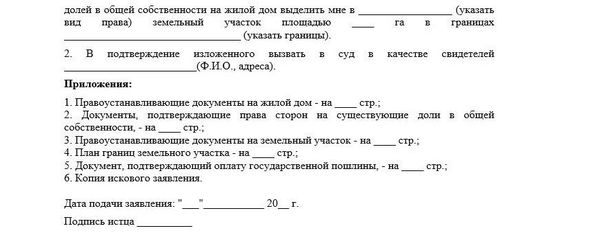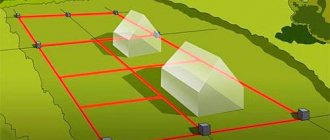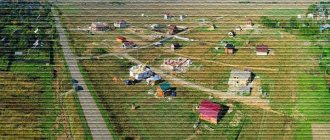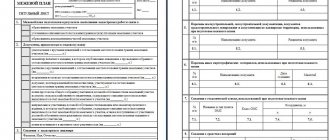What is a disputed land plot?
Land, like other real estate, can belong to several persons at once. If each owner's shares are allocated, the plot is in shared ownership. If not, the land is jointly owned by such persons. Moreover, even if it is not their property, several citizens at once can use it with the right of perpetual use.
Such options for joint ownership/use of land are often accompanied by disputes between landowners. For example, if one of them is not satisfied with the current procedure for using the land plot for the following reasons:
- the owner uses a significantly smaller plot, disproportionate to his share;
- other owners do not allow the rightful owner to use the site;
- due to the specific location of the site, full use of utilities is available only to one of the owners;
- there are no common areas on the common site, in particular for travel/passage to buildings or to other areas;
- functional use of the land plot by one of the owners is impossible due to obstacles from the other owners, and so on.
A piece of land for which the owners cannot agree on the terms of joint ownership is considered disputed. The only way out in this case is to establish rules for its use.
A dispute may arise in relation to any common area:
- the disintegrated lands of the former collective farm;
- joint property of former spouses;
- land at an apartment building.
Determining the procedure for using a land plot in an apartment building, as well as shared and matrimonial property, follows a single procedure.
Sample application
To apply, you can use the prepared general form and fill it out.
The form is available for downloading and viewing.
When drawing up a statement of claim, the following requirements of Art. 131, art. 132 of the Civil Procedure Code:
- the claim must contain details of the court;
- information about the plaintiff and defendant, interested parties (the circle of persons who own the property right to use the land property);
- the subject of the dispute is the determination of the limits of the rights of the parties to the dispute;
- the descriptive part of the claim must contain legal facts and events indicating a violation of the order of use in relation to the land plot, or the impossibility of determining such an order and attempts to voluntarily resolve the dispute;
- the plaintiff must indicate to the court the corresponding requirement - to determine the procedure for use;
- list of documents attached to the statement of claim to confirm the existence of the right (share in the right);
- receipt of payment of mandatory state duty;
- copies of the number of persons participating in the case are attached to the application. It is the responsibility of the court to send copies to the parties.
This is important to know: Definitions of the procedure for using an apartment in shared ownership
Note!
When determining the procedure for use of a land plot, the court does not take into account the expiration of the limitation period.
Based on the results of the consideration of the case, a court decision is made, by virtue of which none of the other owners can claim a different procedure for use. The procedure for determining the procedure for using a land plot requires an integrated approach due to the complex subject of legal relations, or more precisely, the regime for using the object in terms of the variety of types of property rights.
The interested party has the right to resolve the dispute by concluding an agreement in any form, otherwise, the assistance of a lawyer is required to draw up a statement of claim and consider the case in court.
The category of cases regarding property rights to land is distinguished by its complexity and involves lengthy legal proceedings. The complexity of the case, the amount of time spent, the qualifications and experience of the lawyer - all can affect the amount of remuneration for the work done by the lawyer. Objective factors influencing the cost of services include the region where they are provided. Moscow and other large cities in our country, due to the high standard of living of the working population, set higher prices for similar work compared to the regions.
We are ready to provide a full range of consulting services regarding the use of land plots. Regardless of the region where the subject of the dispute is located and its parties, our experienced specialists will provide informative legal support taking into account current legislation.
Procedure for using land
The procedure for using land is the rules for the actual implementation by land owners/users of their rights arising from the right of ownership/perpetual use of land. It involves determining the scope of rights in relation to a specific site that a person is entitled to.
Thus, the procedure for using a land plot in shared ownership, according to clause 2 of Art. 247, in general situations, involves the allocation to each owner of a part of the property commensurate with his share.
Thus, if a plot belongs to 4 persons and each of them owns an equal share, they should be allocated ¼ of the entire area of the plot, which they can use at their own discretion. If the actual use of the land plot does not allow this, the owner has the right to demand that other shareholders pay him compensation. Its amount must be proportionate to the part belonging to him.
In addition to personal shares, the procedure for use also involves the determination of parts of the site that are in common use: roads for travel and passage of other owners, utilities, common buildings, and so on.
For obvious reasons, when using land, the functional purpose of the land should be taken into account. Thus, if a territory is allocated for agricultural activities, housing construction cannot be organized on it. On the other hand, if agricultural land or land for construction is not used for its intended purpose for a certain time, it may even be withdrawn.
Details are contained in the article “What is a land share”.
Determining the rules for using the site
Not everyone knows how to determine the procedure for using a land plot, so it is worth researching the legal requirements.
According to paragraph 1 of Art. 247 of the Civil Code, the procedure for using a common allotment is determined by mutual agreement of all co-owners of the land. It can even be concluded orally.
In this case, it is not at all necessary that each of the co-owners will receive equal parts of the property.
For example, parties to an agreement may agree that someone will get a larger area, but of poorer quality. Or, for example, there will be a public road on the property of one of the co-owners.
If an agreement on the terms of use was reached through lengthy negotiations, the parties are recommended to sign an agreement for joint use of the land plot. The participants will add to it any provisions regarding the procedure for use and determine the amount of compensation if any of the co-owners is left without an allocated share.
A similar procedure must be followed in cases of using the common land of an apartment building, especially if it is low-rise.
Apartment owners, as a rule, have common ownership of the land under the house. Everyone uses the surrounding area at their own discretion: some plant flowers, others build a garage. To prevent them from having claims against each other, an agreement on the use of land between neighbors can be concluded. For this purpose, a general meeting should be convened.
To determine fair use, residents must take into account the provisions of Art. 15 . According to them, the share in the right of common ownership, including land, is commensurate with the area of their apartments in proportion to the area of common property. That is, the more spacious the apartment, the more land the tenant is entitled to.
If they were unable to reach agreement, the terms of use will have to be determined in court. The judicial authority, according to paragraph 37 of the Explanations, approved. , when assigning a procedure for use, take into account:
- the need of each owner for a land plot;
- the possibility of sharing the allotment;
- the actual established procedure for using the land plot, even if it does not exactly correspond to the size of the shares belonging to the co-owners.
Learn more about how land use is not only a set of laws aimed at using land funds, but also the management of land activities and the exploitation of land through own/hired labor.

Signing the agreement
As mentioned above, co-owners can voluntarily enter into an agreement on the joint use of their land plot, formalizing it in the form of a written agreement.
An agreement to determine the procedure for using a land plot does not have a form or rules for its conclusion established by law, therefore it is believed that it is enough for co-owners to sign the agreement without notarization. When drawing up a draft agreement, it is advisable to take into account the following recommendations:
- An agreement to determine the procedure for use is inherently a multilateral transaction, and therefore, to gain legal force, it must be drawn up in writing.
- The sharing agreement must contain:
- full name of co-owners indicating the size of their shares;
- details of certificates of ownership/extracts from the Unified State Register of Real Estate;
- cadastral information: location, area and other features of the site;
- a detailed description of the rules of use in relation to each owner.
- The claims of each of the participants, as well as the waiver of claims to use the land, must be listed in the agreement.
All co-owners must be notified at a general meeting about the establishment of rules for use by agreement. It is worth informing them in writing about such a meeting.
Those who do not have experience in drawing up documents can download a sample agreement on the procedure for using land in 2020 and carefully read the text.
How to determine the procedure for using land under an agreement?
Good neighborly relations always benefit the common cause. Co-sharers can agree on the boundaries of the plot, increase/decrease their “sections”, erect a fence, lay a path and treat problem areas. The main condition is the consent of all co-owners of the territory. The new order should not infringe on anyone's interests.
If you want to change the size of shares, but don’t know how, read our instructions “Agreement on the redistribution of shares in common property.”
What to do?
So, in order to draw up and register an agreement, use our instructions:
- Discuss important points in the operation of the territory.
- Prepare documents for the land.
- Draw up a draft agreement - in simple written form using the sample.
- Have the agreement certified by a notary (optional).
- Apply signatures and make amendments if necessary.
- Go to the MFC or Rosreestr to register the agreement.
There are no particular difficulties here, however, if there are residential buildings on the site, notarial or judicial intervention will be required (see “How to divide a house and land that are in common shared ownership?”).
Example:
Saratova and Rasskazov inherited a plot of land that they inherited from a common relative. Both heirs received ½ share of the land, but did not establish the procedure for exploiting the allotment. A misunderstanding arose, but, fortunately for the shareholders, they were able to find a compromise and decided to draw up an agreement. Saratova grew vegetables, fruits and decorative flowers all her life. The woman was interested in cultivating the fertile soil, which constituted ⅔ of the entire plot. Rasskazov was a retired military man; he was not involved in gardening, but had an economic interest. He used the area to store inventory, spare parts and equipment in a barn. The co-owners agreed that the woman would receive ⅔ of the land territory, and the man would receive the remaining ⅓ part. The established procedure did not correspond to equality of shares, but took into account the interests of both shareholders.
Sample agreement on the procedure for using land
The agreement is drawn up in any form, indicating important agreements.
Documents for the agreement
Before you begin to determine the order, you need to collect the available documents for the land. The responsibility lies with all shareholders, since they come to a common decision and are interested in dividing the boundaries.
What is included in the package of documents:
- statements from co-owners of the land plot;
- Russian passports or birth certificates of children;
- cadastral passport of the plot (extract from the Unified State Register of Real Estate) - shows that the land has been registered with cadastral registration in Rosreestr;
- certificate of ownership or extract from the Unified State Register of Register of Property Rights to the share(s);
- power of attorney to register changes if his representative applies instead of the applicant.
This is important to know: Give up your share of ownership of the apartment in favor of another person
How much will it cost?
Costs are associated with drawing up a draft agreement between shareholders. Participants in the transaction pay the cost equally, but other options are possible.
- Registration of the procedure for use with the Rosreestr body is free.
In fact, there may not be any expenses, but you will have to draw up an agreement according to the sample and follow the registration procedure.
Determining the conditions for the use of land in court
If the issue of land use cannot be resolved peacefully, you can resort to judicial proceedings. To initiate a process to determine the order of use of land, co-owners must file a corresponding claim.
Moreover, the size of each share will not be the only criterion that the court takes into account. In addition to the size of the share, other aspects will be taken into account, which have already been discussed above.
You need to be prepared for the fact that the court may not determine the procedure for using the land according to shares. For example, the judge will come to the conclusion that the new owner’s requirement to allocate a specific area in kind from a common plot is unfounded.
The rules themselves are not subject to any state registration. In case of non-execution, the court decision may become the basis for initiating enforcement proceedings and attracting bailiffs.
Filing a claim to determine the order of land use
The statement of claim is the basis of the legal process. It not only informs the court about the dispute that has arisen, but also offers options for resolving it. Thus, the plaintiff can ask not only to determine the rules of use, but also to offer a possible option.
The statement of claim is filed in court according to the rules of exclusive jurisdiction. According to Art. 30, he is sent to the magistrate’s court at the location of the land plot.
Before filing a claim, the plaintiff pays a state fee in the amount of 300 rubles (clause 3, clause 1, article 333.19.
The participation of the plaintiff in the process is mandatory. He must appear in court on the day of the hearing to support his position, give explanations about the issue being resolved, propose ways to solve the current problem, and attract witnesses and experts.
A third party by proxy, for example, a qualified land lawyer or attorney, can represent and defend his interests in court.

How to file a claim
When drawing up an application, you must be guided by the requirements of Art. 131 Code of Civil Procedure. According to them, the text of the document should indicate:
- name and details of the court and parties to the process;
- description of the current situation: conditions for the emergence of common property;
- the size of the shares of each of the co-owners;
- details of title certificates and documents;
- established order of use;
This is a brief description of the contents of such a statement. To make sure you don't miss anything important, check out the sample claim.
If the plaintiff does not have experience in drafting procedural documents, it is worth contacting professional lawyers.
Attracting experts
Since any disputed plot has a history of use (buildings, plantings, etc.), in practice, allocating an ideal share of land seems difficult. In order to find a compromise between the violated rights of the shareholder and the persons who actually use the site, the court may request an opinion from a cadastral engineer.
The expert analyzes the current situation, conducts a land management examination and offers several possible options for realizing the rights of co-owners. His conclusion is not mandatory for the court - it is assessed in a general manner and is only one piece of evidence.
And yet, since the expert's position is impartial and comprehensive, courts usually take it into account when rejecting the parties' proposals.
The vast majority of litigation comes down to choosing the best option from the models proposed by the cadastral engineer. Therefore, for a successful outcome of the case, the plaintiff is recommended to obtain an expert opinion on possible options before filing a claim.
The plaintiff can use the most suitable option as the basis for his claims. A reference in the application to the conclusions of a specific expert will increase the chances of a positive decision.
Arbitrage practice
The only criterion when determining the conditions for the use of plots by shared co-owners is the size of their shares: what is the share, so is the actual size of the land used. But judicial practice in determining the procedure for using a land plot has taken a different path.
Courts, as a rule, give preference to options that take into account the actual conditions for the use of land by co-owners. It is logical to assume: if the existing land use model has been applied for many years, but none of the co-owners has yet declared their rights to the land, then everything suits them.
This position has a legal basis. According to Art. 8 of the Civil Code, the rights and obligations of citizens can arise not only on the grounds provided for by law, but also due to the actions or inaction of citizens.
Registration of the right to use a land plot in court
Sometimes neighbors are uncompromising and intractable, and do not agree to draw up an agreement on the rules for using the land. The only way out is to go to court.
The owner whose rights have been violated must contact the magistrate with an appropriate claim. However, first it is necessary to determine the grounds for the application, the availability of documents for the site, the evidence base, if you plan to secure the right to use a site that has been in use for many years.
The defendant in the claim will be the shareholder who violates the rights of the plaintiff.
Why hire an expert
The parties can independently delineate the boundaries of use of the object, but it is recommended to conduct a land management examination.
The need to involve experts can be applied to the court at the pre-trial stage. As a result, the judge will issue a ruling on ordering an examination. Owners also have the right to contact an organization that has a license to conduct expert work.
The specialist will help determine the boundaries of the property of each owner and draw up a conclusion containing information:
- what area does the plot occupy, are there any inconsistencies in the title documents regarding the issue of land areas;
- are there any buildings at the site;
- whether the plot does not go beyond the boundaries of the territory indicated in the cadastral documents;
- are there other options for division and how can the dispute be resolved;
- can one of the shareholders pay compensation to the other and in what amount;
- whether each of the shareholders must carry out work related to bringing the territory into proper shape (removal of buildings, uprooting of trees and other work);
- Are there any areas on the site that are not suitable for use?
Determining the order of use of a simple (rectangular) plot is not difficult. To allocate a share in an uneven area, you will have to contact a specialist.
This is important to know: Allocation of shares to children after repayment of the mortgage with maternal capital
If there are potentially life-threatening objects near the site, it is necessary to allocate a buffer zone. Its size will be included in the expert report.
The information received from the specialist indirectly influences the judge’s final decision.
Form, content, sample claim
Whether the claim will be accepted by the judge for consideration depends on the correctness of the filing of the claim in court. If the requirements are not met, the document will be sent for revision. To prevent this from happening, the form and content of the claim must comply with Art. 131 Code of Civil Procedure of the Russian Federation. The document states:
- In the upper right corner: the name of the judicial authority, full name of the plaintiff, defendant and other interested parties, their addresses and contact details.
- The title of the document is “Claim to determine the right to use land.”
- The essence of the claim. It is necessary to state who owns what shares, on what grounds, whose rights were violated, and to indicate facts of non-compliance with the rules for using the land plot. It is necessary to emphasize that it was not possible to reach agreement on the procedure for using the land.
- A petition stating a request to determine the procedure for using the land.
- List of applications.
- Date and signature of the plaintiff.

The number of claims filed with the court office must be equal to the number of interested parties in the case.
Documentation
The following documents must be included in the application:
- Cadastral passport.
- Title documents for the object of dispute. This may be a certificate of ownership, an extract from the Unified State Register of Real Estate, and if the share of the plot is determined by the share in the homeownership, it is necessary to provide an extract from the Unified State Register of Ownership of the house.
- Expert opinion.
- Receipt for payment of state duty.
Price
When filing a claim, you will have to pay a state fee of 300 rubles . (clause 1.3 of article 333.19 of the Tax Code of the Russian Federation). The receipt must be attached to the document, otherwise the application will not be accepted for consideration. Additional expenses may be associated with obtaining an expert assessment of options for dividing a land plot, the cost of which depends on the complexity of the work.
The procedure for making a court decision on the right to use a land plot
After the claim is accepted, a hearing will be scheduled.
The judge pays attention to the following points:
- opinion of a cadastral engineer;
- the established procedure for use;
- witness statements;
- the grounds on which the participants in the process became owners of shared property.
Cases of this kind are resolved before the expiration of 2 months from the date of filing the application. If the plaintiff or defendant is not satisfied with the judge's verdict, they are given the opportunity to appeal the decision through the appeal procedure.
Based on the results of the meeting, a decision is made that is subject to enforcement. On its basis, a writ of execution is issued. If the provisions of the document are violated, one of the parties can contact the Federal Bailiff Service, submit a writ of execution and an application to initiate enforcement proceedings. As a result, the site will be forcibly vacated, and a fine will be imposed on the violator.
FREE CONSULTATIONS are available for you! If you want to solve exactly your problem, then
:
- describe your situation to a lawyer in an online chat;
- write a question in the form below;






